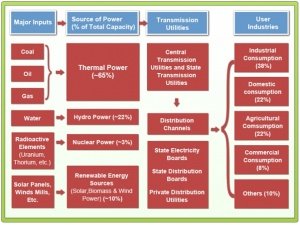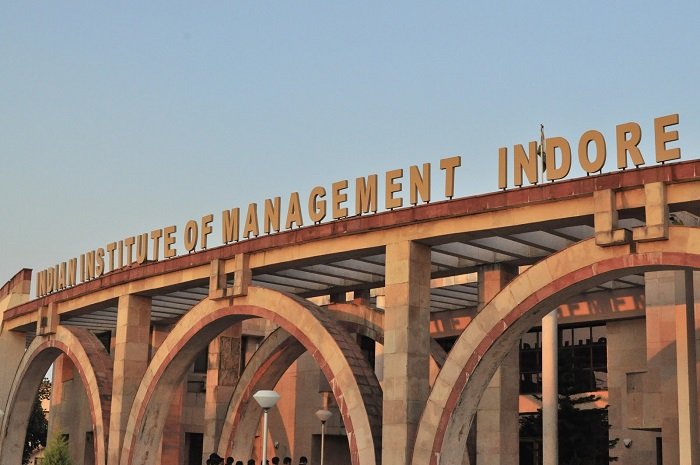India Shining was once the unofficial slogan for Indian Economy. Growth of the Indian Economy was at its peak when the slump in the global markets due to the 2008 sub-prime crisis led the economy to slow down.
One of the key factors of the growth of the Indian Economy, or any other economy for that matter is the energy requirement and supply in that country. Energy plays a very important role in industrial production and the households. It has become extremely important to boost the growth in the energy sector of the economy.
Current State of Indian Power Sector
Power is the core industry as it facilitates development in various sectors of the Indian Economy like agriculture, manufacturing, railways etc. Currently India has the fifth largest electricity generation capacity in the world. It is considered that the growth of the economy is expected to boost the electricity demand in future. Also, there is a strong correlation between the GDP growth and increase in power generation capacity of an economy.
India saw a total capacity addition of approximately 54,000 MW during the 11th Five Year plan, of which approximately 47 per cent was contributed by the central government, 34 per cent from the state government, and a little over 19 per cent from the private sector.
In India, power is generated by State utilities, Central utilities and Private players. The share of installed capacity of power available with each of the three sectors is 48%, 31% and 21% respectively. Few of the top public sector companies include National Thermal Power Corporation (NTPC), Damodar Valley Corporation (DVC) and National Hydroelectric Power Corporation (NHPC). Some key companies in the private sector include Tata Power and Reliance Energy Limited.
Working of Power Industry
The diagram below shows the flow chart for the production of power for use in various other sectors.
In India, power is primarily generated from the thermal and nuclear fuels, hydro power generation and renewable resources. The power thus generated is distributed for consumption by industries, households, agriculture, commercial etc.
Thus we see that power forms a major input for various other sectors/industries for the economy to grow.
Thermal Power – In India, major proportion of power is generated from thermal sources where the main raw material used is coal. Around 83% of thermal power is generated using coal as a raw material whereas 16% of thermal power is generated with the help of gas and 1% of thermal power is generated with the help of oil.
Hydro Power – Hydroelectric power or hydroelectricity is electrical power which is generated through the energy of falling water. India has hydro power generation potential worth 1,50,000 MW, of which only 25 % has been harnessed till date.
Nuclear Power – A Nuclear Power Plant is a thermal power station in which the heat source is one or more nuclear reactors. A nuclear reactor is a device to initiate and control a sustained nuclear chain reaction. In the process, heat is generated which is then used to generate electricity.
Renewable Energy Sources – The energy obtained from renewable sources like sun, wind, biomass can be converted into power. Renewable energy sources have great potential to contribute to improving energy security of India and reducing green-house gas emissions. India is among the five largest wind power generators in the world.
Challenges in the Industry
· 1. Fuel Shortage
Power industry has long gestation period and is a highly capital intensive industry. Shortage of fuel can be a major challenge in the long term. Most of the power plants use coal(to the extent of 65%) for producing power and our coal reserves are depleting fast enough to forecast a shortage of 283 metric tonnes of coal per annum by FY17. Additionally, there is also a shortage of natural gas as fuel. If these commodities are imported from the world markets, the cost production will go up leading to the rise in the cost of production of products in other sectors. The higher cost of production will lead to increased prices and hence inflation.
As a remedy to the shortage of fuel, the government of India has planned for the deregulation of the coal sector for competitive resource allocation. CII had set up a Task Force to study allocation of mineral resources worldwide, with special reference to coal, and recommend approaches for allocation in India. These reforms will ensure transparent allocation and also faster exploration and development of coal blocks.
· 2. Approval & Licences
Land acquisition is the biggest challenge that faces the power sector. Also, obtaining licences for environmental approvals is also difficult. There is no transparent route and a number of government bodies need to be contacted for the clearances.
The primary concerns for the same are over environmental pollution, issues w.r.t. rehabilitation, deforestation etc.
· 3. Degrading financial health
Eight state electricity boards (SEBs) had stopped making payments to NTPC in 2011, despite getting discounts of up to 2 per cent on immediate payments, and 1 per cent on payments made within one month. The losses of distribution utilities in India were pegged at Rs 75,000crore (US$ 13.9 billion) in 2011, and are expected to rise to Rs 1.16 trillion (US$ 21.4 billion) by 2014-15.
· 4. Risk associated with the bidding process
The power sector is inviting bids from private investors, which in turn is increasing price competition. This is a positive sign for the sector but it might increase risk for private companies primarily because during the bidding process, power generation companies normally quote prices for a period of 25 years and power transmission companies quote for a period of 35 years.
Way Forward – Power reforms 2012-13
In Union Budget 2012-13, the Indian Government has recognised key driver for the growth of GDP going forward. So the government is acting towards reforming the sector through various reforms and policies.
The government has waived of Basic Customs Duty (BCD) on coal imports and reduced countervailing duty (CVD) from 5% to 1%. This is expected to benefit numerous private players who depend on imported coal to carry out day to day operations.
The government has directed Coal India Limited (CIL) to sign agreements with power plants that are in long term power purchasing agreements (PPA) with distribution companies (DISCOMS) to reduce the cost of raw materials.
In addition to allowing External Commercial Borrowings (ECB) to provide additional finance to existing power projects, the government allocated Rs 100 billion (US$ 1.8 billion) in the form of tax free bonds to fund infrastructure projects in the power sector over FY13. Further, the tax on interests earned on ECBs was reduced by 15 per cent to 5 per cent. This is expected to increase the working capital for companies in the sector.
The government proposed a deduction of 100 per cent on the profits of power sector undertakings set up in the next one year, up to 10 years. The former Finance Minster, Mr Pranab Mukherjee, also proposed 20 per cent depreciation on new assets acquired by power generation companies in the initial year.
The government’s moves are expected to encourage more companies to enter the Indian power sector, while simultaneously helping existing companies to expand their operations. The budget also provided an exemption of 100 per cent on CVD for equipment used in solar or thermal projects.
This will encourage companies operating in the power sector to focus on renewable energy sources rather than conventional sources.
Conclusion
The power sector in India is currently in the developing stage, and supports the growth of various sectors, such as infrastructure, manufacturing, commercial enterprises and railways. Therefore, it is a key enabler for India’s economic growth, and has historically shown similar growth trends as compared to the economy.
Currently, the primary fuels used for power generation in India are non renewable, such as coal and natural gas. However, given the expected increase in future demand, the government’s focus has now shifted to capacity additions using renewable sources of energy.
These positive developments along with initiatives on CVD and BCD for coal import as taken in the 2012–13 Union Budget address some key challenges in the sector. Through the budget, the government also provided additional capital by allowing ECBs and allocating Rs 100 billion (US$ 1.8 billion) in the form of tax free bonds.
It is expected that the power sector will be one of the most dominant sector in near future.


































